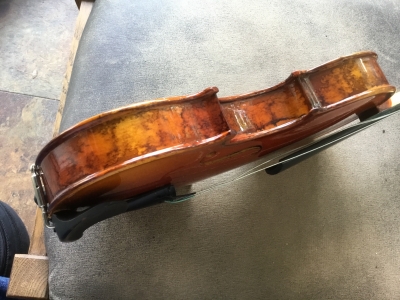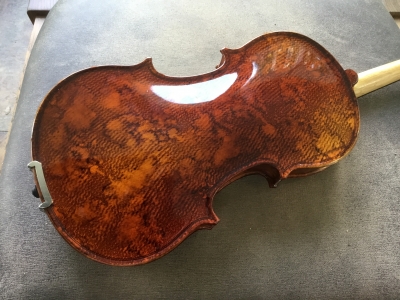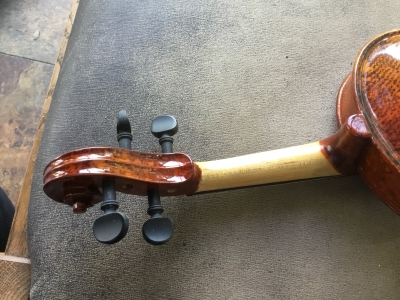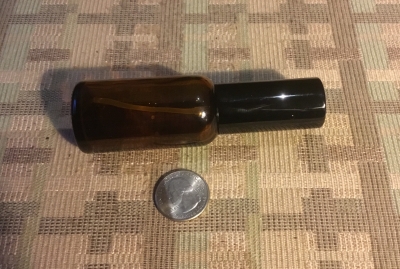Welcome to our forum. A Message To Our New and Prospective Members . Check out our Forum Rules. Lets keep this forum an enjoyable place to visit.
Currently working on errors from the latest (SimplePress) forum update. Many issues have been resoled and others are being worked on. Thank you for your patience.
 Topic RSS
Topic RSS



 (0 votes)
(0 votes) Regulars
 Offline
Offline

I purchased a fractional violin just to figure out how the splotched pattern was added to the finish. I know that water color artists and silk cloth crafters apply sea salt or granules of sugar to wet paints to achieve similar. Suggestions from crafters or artists on how to achieve this would be appreciated.
It is a Chinese violin made by a manufacturer having pianos as a main product. They use the same process on one of their upright piano models.
Success is the progressive realisation of a worthy ideal. —Earl Nightingale.
Regulars
 Offline
Offline








This pattern is NOT done with salt - it's a different 'watercolor' effect.
Step #1.) Prepare a clean surface.
- Looks like (in the photo) they might have sealed the wood first, with a spray coat of light or clear varnish & let dry before starting - to allow for better flow of the darker stain in the next step.
- You can experiment with different unfinished wood.
Step #2.) Spray a mix of darker Varnish and solvent over the surface.
- Until you've done this a few times, maybe choose a slower drying solvent to begin with.
- Do next step before this varnish completely dries!
Step #3.) Keep parts horizontal for this - apply random drops of just solvent (or try drops of diluted clear varnish - won't spread as fast)) - WHILE SURFACE IS STILL SLIGHTLY WET or at least tacky.
- Several drops in the same spot yields larger blotches.
- You can use a handheld hair dryer to manipulate the pattern while adding drops - just keep it moving, don't want to heat the surface!
- You can also get drastically different results - depending on just how wet your darker varnish solution is. You can experiment with wetter areas vs. almost dry, before applying drops of solvent (or clear varnish) - just be very careful of runs.
- Solvents make a difference, because they can have different drying times.
Step #4.) While still slightly wet, in the photo, they have laid down a textured cloth to blot excess solvent/stain and to stop/fix the pattern.
- I'd rather use a hair dryer, but you can also blot with a slightly scrunched up piece of disposable cloth (use a different area of the cloth each time you blot) for a different pattern.
- Some people use scrunched up plastic bags to blot and leave more pattern - just make sure your solvent type doesn't dissolve them.
- If not happy with resulting pattern - add more drops of diluted stain or just solvent, then blot again.
- Harsh lines can be softened using a spritz or two of solvent - from a small, solvent-proof, plastic pump or trigger spray bottle. Let dry.
Step #5.) To finish, maybe lightly sand before spraying a topcoat of clear or lightly tinted varnish. Looks like (in the photo) they also hit it with a couple random bursts of reddish tinted color from a touch-up spray gun.
The key is learning some consistency. Experiment a few times to learn how to get a 'random type' pattern you like.

I've done this technique on watercolor paper (used H2O as solvent for watercolor and acrylics, Alcohol as the solvent for inks), but had the most fun with it on sandblasted glass! I used 2-part automotive polyurethane, with dyes and MEK as my solvent. You can even lay a resist down in any shape (apply before step #2 and pull up after step #4).
- Emily
Regulars
 Offline
Offline

@ELCBK and others.
I purchased several small glass atomising bottles. I have developed “dry eye” and I do not like the process of using an eye dropper to apply artificial tears. A spritz of the solution is much more satisfying. No clue if they will hold up containing mentioned solvents, but I am game to try. My first attempt will be with leather dye and alcohol.
Please explain what a resist is to an art deprived individual.
I think you have nailed the likely technique used and have given me enough info to reverse engineer it.
I do not like the mesh effect on the corpus back and wonder if it is an artefact of a “rushed” job. I wonder if the dye is introduced by transfer from the mesh and blotched as a secondary process.
Success is the progressive realisation of a worthy ideal. —Earl Nightingale.
Regulars
 Offline
Offline

Regulars
 Offline
Offline








@Irv -
The overall effect on the violin could be considered a simple dispersion technique, since solvent is used to push aside areas of the dark color - which reveals the lighter-colored base underneath.
Also, think in 'layers'.
If you start with an extremely light colored base, and the next layer you apply has dark areas of high contrast, you can follow with a layer of transparent tint (applied overall) to tone down/even out that contrast.
I do not like the mesh effect on the corpus back and wonder if it is an artefact of a “rushed” job.
The 'mesh' effect - especially if only on the back, was caused either by laying the violin down on something with that texture, while the varnish was still wet, or was 'printed' on - by touching a painted surface that was textured.
I wonder if the dye is introduced by transfer from the mesh and blotched as a secondary process.
Any object left on a wet paint surface to dry - when that object is lifted, it will leave behind an outline/edge consisting of concentrated pigment. This is the most obvious when using pigment suspended in a transparent paint mixture with a high level of solvent.
You can 'comb' through paint for a wavy texture, but not the case here.
Please explain what a resist is to an art deprived individual.
🤣 "Resistance is futile!"
Sorry, I probably shouldn't have mentioned 'resist' - it was only meant for further exploration and doesn't have anything to do with the painting technique used on that violin.
A 'resist' = masking = any, completely removable, barrier that protects the surface from one of your painting techniques.
Examples: masking tape, contact paper, sheet of acetate, cardboard, cloth/plastic/metal mesh, even your hand... anything that blocks the paint or solvent from reaching the surface.
A liquid 'resist' is applied in liquid form, dries solid - so can be removed without damage to the original surface or surrounding artwork, e.g., 'masking fluid' (dries rubbery & peels off) or Wax.
Regulars
 Offline
Offline

@Fiddlerman . Request now understood.
Upon receipt of “dry eye” diagnosis, I did a deep dive on the work of Dr. Jeffrey Gilbard (the guy who formulated Thera Tears). And I started a badly controlled experiment on myself.
Dr. Gilbard encouraged dry eye sufferers to take Flaxseed Oil, Vitamin E, and Vitamin D3. Doing that.
My cousin, a biologist working for a Boston pharmaceutical company, told me about a therapy where a heated detergent solution is electro mechanically messaged to the eye lids. So I applied baby shampoo to a warm wetted face towel, placed it over my closed eyes in a shower, and used the back of an electric tooth brush for the message (which is the strangest feeling ever).
And I also spritz Thera Tears as needed (typical only after a shower now, which is likely because the baby shampoo solution removes the lubricating component of naturally formed tears).
Not a perfect solution but I can read again and my vision has dramatically improved.
An now, as requested, the photo.
Success is the progressive realisation of a worthy ideal. —Earl Nightingale.
1 Guest(s)


 Log In
Log In Register
Register
























